Experimental Study on Erosion and Sedimentation Patterns Downstream of a W-weir in a Sinusoidal Mild Bend
Abstract
:1. Introduction
2. Materials and Methods
2.1. Experimental Setup
2.2. Dimensional Analysis
3. Results and Discussion
3.1. Scour Typologies
3.2. The Effect of the Angle of the Inner Arms of the W-Weir on Sediment Transport
3.3. Effect of the Height of W-Weir on the Scour Volume
3.4. Scour Morphologies and Maximum Scour Depth
4. Conclusions
- By installing a W-weir, flow over the inclined sections of the downstream-oriented crest of the weir in the flume forced the flow towards the center of the flume. A W-weir can be installed in a river bend for bank protection.
- By installing a W-weir, local scour increased and the bed upstream did not change appreciably. No significant deposition of sediment occurred upstream of the structure. Downstream of the weir, two types of scour morphologies (type B and type C) were formed. The weir with scour type C can be designed in the river with the case of an erodible bank, because one scour formed in the middle of the channel and the whole near-outer bank flow deviated toward the flume centerline.
- The size of scour increased with increasing angle between the two inner arms (), the size of scour hole was minimum when the inner angle of arms was 64°. By increasing the inflow Froude number, the maximum scour depth increased.
- The size of scour hole in three heights of the weir ( 0.5, 1, 1.5) in different inflow Froude numbers was tested. The minimum scour depth occurred at 0.5 for the tests with all angles between inner arms. By increasing the inflow Froude number, the maximum scour depth increased.
Acknowledgments
Author Contributions
Conflicts of Interest
References
- Rosgen, D.L. The cross-vane, W-weir and J-hook vane structure: Their description and application for stream stabilization and river restoration. In Proceedings of the Wetlands Engineering and River Restoration Conference, Reno, VA, USA, 27–31 August 2001; ASCE: Reston, VA, USA; pp. 1–22. [Google Scholar]
- Blanckaert, K.; de Vriend, H.J. Secondary flow in sharp open-channel bends. J. Fluid Mech. 2004, 498, 353–380. [Google Scholar] [CrossRef]
- Bhuiyan, F.; Hey, R.D. Computation of three-dimensional flow field created by weir-type structure. Eng. Appl. Comput. Fluid Mech. 2007, 1, 350–360. [Google Scholar]
- Rosgen, D.L. Natural Channel and River Restoration Short Course Notes; Wildland Hydrology: Pagosa Springs, CO, USA, 1996. [Google Scholar]
- Hey, R.D. River Mechanics and Habitat Creation, Fisheries in the Year 2000; O’Gardy, K.T., Butterworth, A.J.B., Spillett, R.P., Domaniewski, J.C.J., Eds.; Institute of Fisheries Management: Nottingham, UK, 1992; pp. 271–285. [Google Scholar]
- Hey, R.D. Restoration of gravel bed rivers: Principles and Practice. In ‘Natural’ Channel Design: Perspective and Practice; Shrubsole, D., Ed.; Canadian Water Resources Association: Cambridge, ON, Canada, 1994; pp. 157–173. [Google Scholar]
- Hey, R.D. Environmentally Sensitive River Engineering. River Restoration; Petts, G., Calow, P., Eds.; Blackwell Science: Oxford, UK, 1996; pp. 80–105. [Google Scholar]
- Shields, F.D.; Knight, S.S.; Cooper, C.M. Incised stream physical habitat restoration with stone weir. Regul. Rivers Res. Manag. 1995, 10, 181–198. [Google Scholar] [CrossRef]
- Shields, F.D.; Morin, N.; Cooper, C.M. Large woody debris structure for sand-bed channels. J. Hydraul. Eng. 2004, 133, 208–217. [Google Scholar] [CrossRef]
- Garda, C.; Castleden, H.; Conrad, C. Monitoring, Restoration, and Source Water Protection: Canadian Community-Based Environmental Organizations’ Efforts towards Improving Aquatic Ecosystem Health. Water 2017, 9, 212. [Google Scholar] [CrossRef]
- Cassidy, J.J.; Gardner, C.A.; Peacock, R.T. Boarman labyrinth-crest spillway. J. Hydraul. Eng. 1985, 111, 398–416. [Google Scholar] [CrossRef]
- Watson, C.C.; Walters, R.W.; Hogan, S.A. Aeration performance of low drop weirs. J. Hydraul. Eng. 1998, 124, 65–71. [Google Scholar] [CrossRef]
- Wormleaton, P.R.; Soufiani, E. Aeration performance of triangular planform labyrinth weirs. J. Hydraul. Eng. 1998, 124, 709–719. [Google Scholar] [CrossRef]
- Kim, J.; Walters, R.W. Oxygen transfer at low drops weirs. J. Hydraul. Eng. 2001, 127, 604–610. [Google Scholar] [CrossRef]
- Kim, H.S.; Kimura, I.; Shimizu, Y. Experimental Investigations of Scour Pools around Porous Obstructions. Water 2016, 8, 498. [Google Scholar] [CrossRef]
- Bhuiyan, F.; Hey, R.D.; Wormleaton, P.R. River restoration using W-weir. J. Hydraul. Eng. 2007, 133, 596–609. [Google Scholar] [CrossRef]
- Bhuiyan, F.; Hey, R.D.; Wormleaton, P.R. Effect of Vanes and weirs on sediment meandering channels. J. Hydraul. Eng. 2009, 135, 339–349. [Google Scholar] [CrossRef]
- Scurlock, S.M.; Cox, A.L.; Thornton, C.I.; Baird, D.C. Maximum velocity effects from vane-dike installations in channel bends. In Proceedings of the World Environmental and Water Resources Congress, Albuquerque, NM, USA, 20–24 May 2012; ASCE: Reston, VA, USA, 2012; pp. 2614–2626. [Google Scholar]
- Scurlock, S.M.; Thornton, C.I.; Abt, S.R. Equilibrium scour downstream of three-dimensional grade-control structure. J. Hydraul. Eng. 2012, 138, 167–176. [Google Scholar] [CrossRef]
- Pagliara, S.; Kurdistani, S.M.; Cammarata, L. Scour of clear water Rock W-weirs in Straight Rivers. J. Hydraul. Eng. 2014. [Google Scholar] [CrossRef]
- Guan, D.; Melville, B.; Friedrich, H. Flow patterns and turbulence structures in a scour hole downstream of a submerged weir. J. Hydraul. Eng. 2014, 140, 68–76. [Google Scholar] [CrossRef]
- Yarahmadi, M.B.; Bajestan, M.S. Sediment management and flow patterns at river bend due to triangular vanes attached to the bank. J. Hydro-Environ. Res. 2016, 10, 64–75. [Google Scholar] [CrossRef]
- Pagliara, S.; Kurdistani, S.M. Flume experiments on scour downstream of wood stream restoration structures. Geomorphology 2017, 279, 141–149. [Google Scholar] [CrossRef]
- Pagliara, S.; Radecki-Pawlik, A.; Palermo, M.; Plesinski, K. Block ramps in curved rivers: Morphology analysis and prototype data supported design criteria for mild bed slopes. River Res. Appl. 2017, 33, 427–437. [Google Scholar] [CrossRef]
- Kurdistani, S.M.; Pagliara, S. Experimental Study on Cross-Vane Scour Morphology in Curved Horizontal Channels. J. Irrig. Drain. Eng. 2017. [Google Scholar] [CrossRef]
- Pagliara, S.; Kurdistani, S.M. Scour downstream of cross-vane structures. J. Hydro-Environ. Res. 2013, 7, 236–242. [Google Scholar] [CrossRef]
- Pagliara, S.; Kurdistani, S.M. Scour characteristics downstream of grade-control structures. In River FLow 2014; Taylor & Francis Group: London, UK, 2014. [Google Scholar]
- Johnson, P.A.; Hey, R.D.; Tessier, M.; Rosgen, D.L. Use of vanes for control of scour at vertical wall abutments. J. Hydraul. Eng. 2001, 127, 772–778. [Google Scholar] [CrossRef]
- Koch, C.; Chanson, H. An Experimental Study of Tidal Bores and Positive Surges: Hydrodynamics and Turbulence of the Bore Front; Report No. CH56/05; Department of Civil Engineering, The University of Queensland: Brisbane, Australia, 2005; p. 170. ISBN 1864998245. [Google Scholar]
- Colebrook, C.F. Turbulent flow in pipes with a particular reference to the transition region between smooth and rough pipe laws. J. Inst. Civ. Eng. 1939, 11, 133–156. [Google Scholar] [CrossRef]
- Bombardelli, F.A.; Moreno, P. Exchanges at the bed sediments-water column interface. In Fluid Mechanics of Environmental Interfaces, 2nd ed.; Gualtieri, C., Mihailović, D.T., Eds.; CRC Press/Balkema: Leiden, The Netherlands; pp. 221–253. ISBN 978-0-415-62156-4.
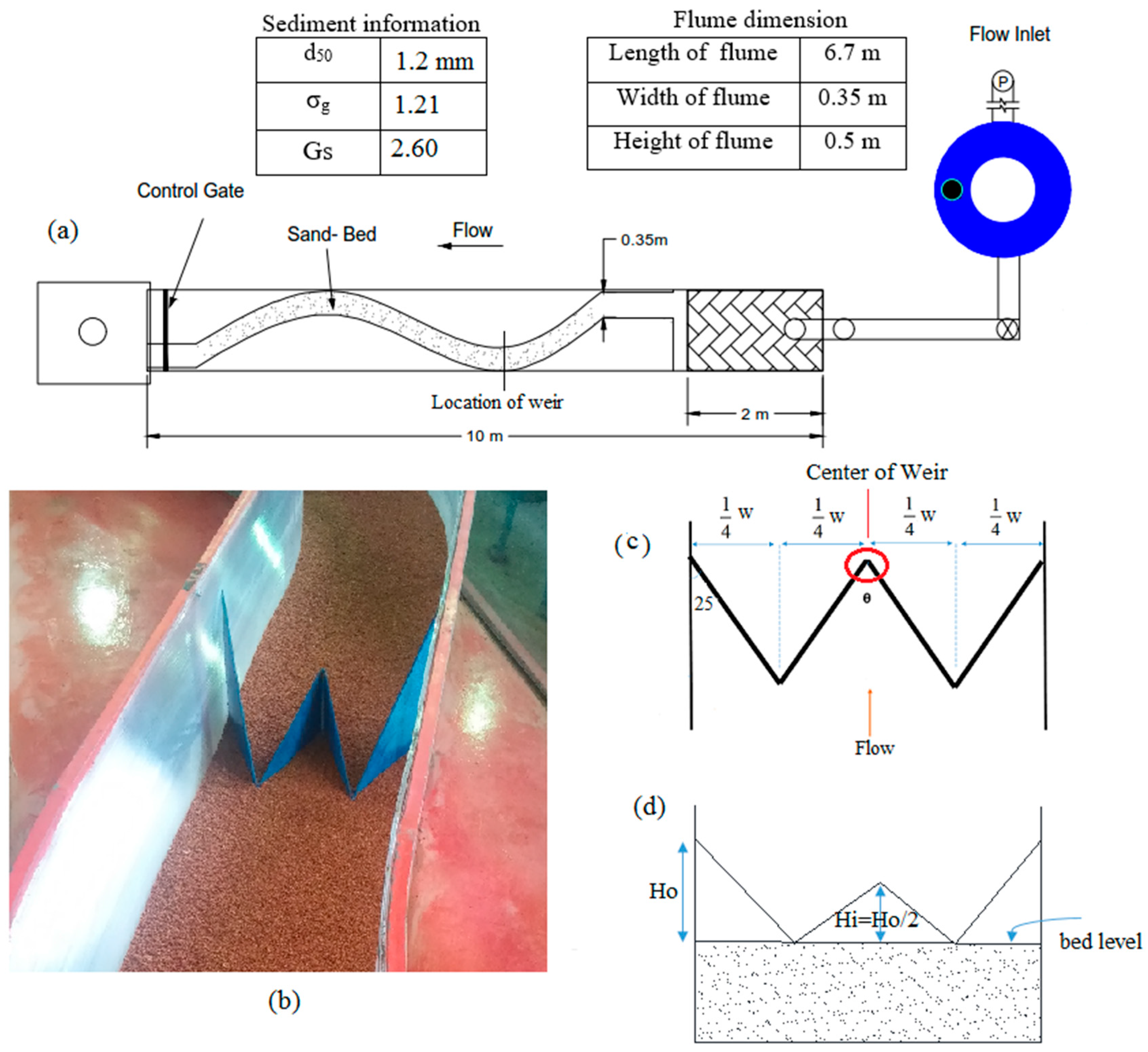
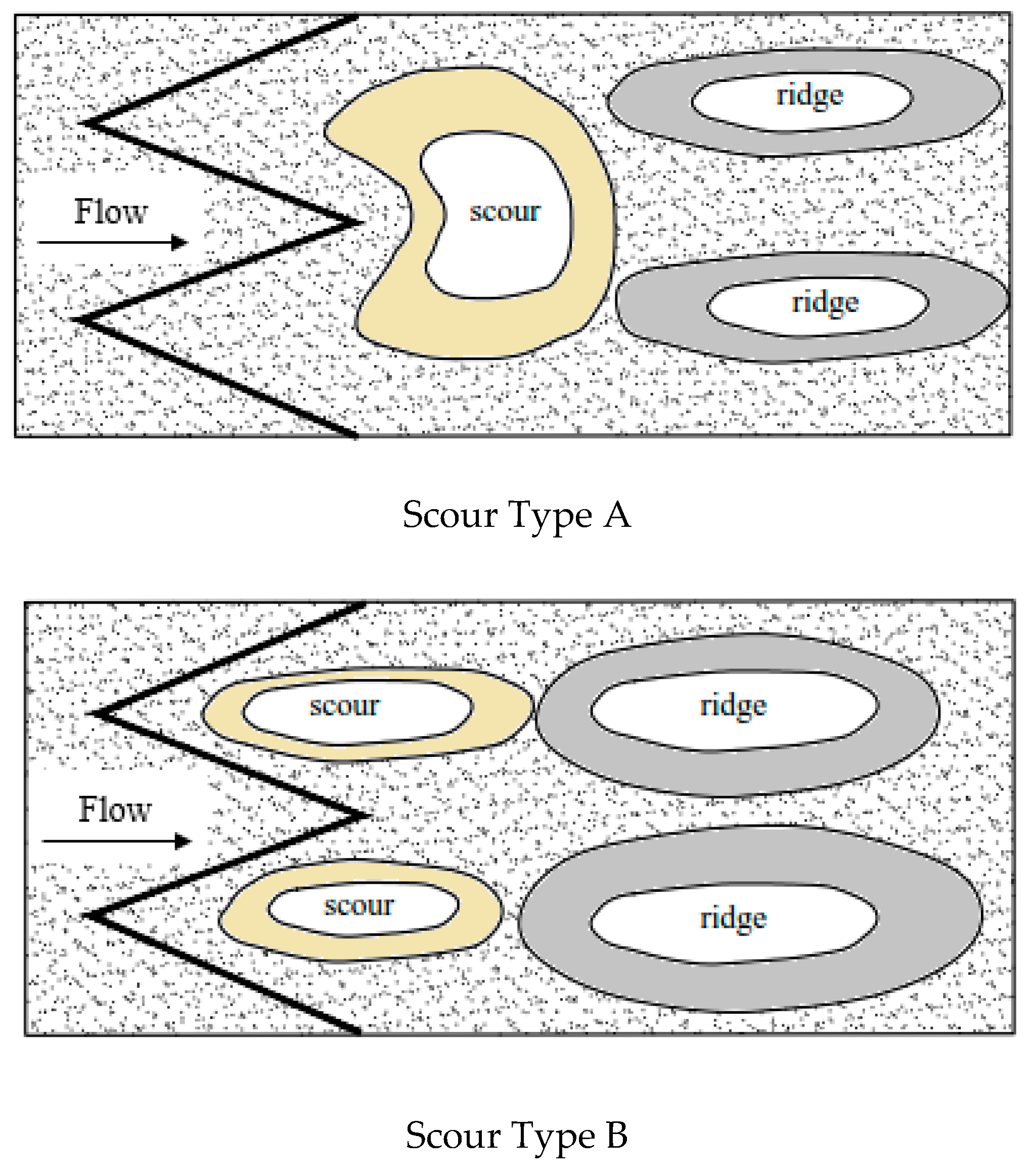
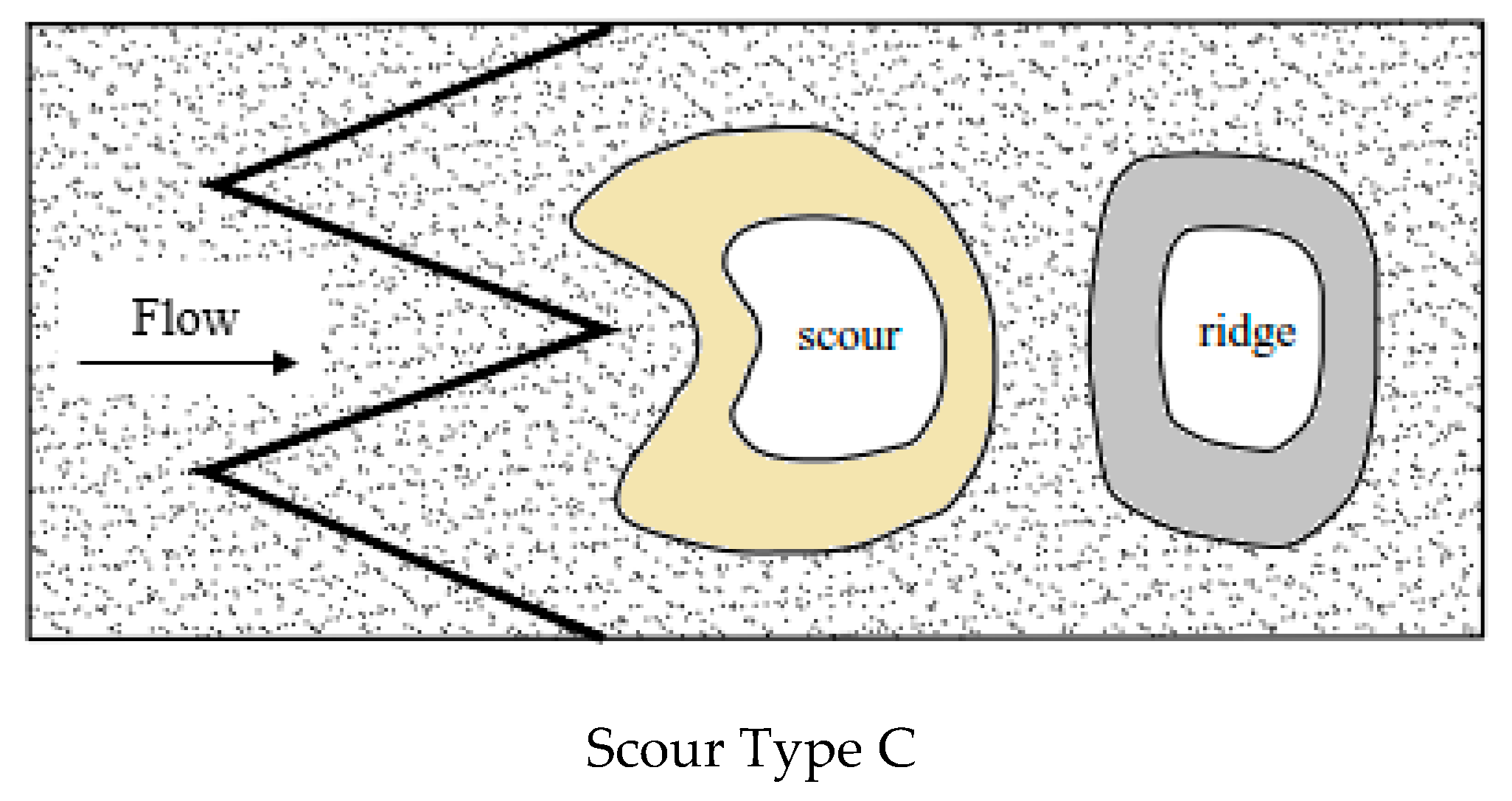


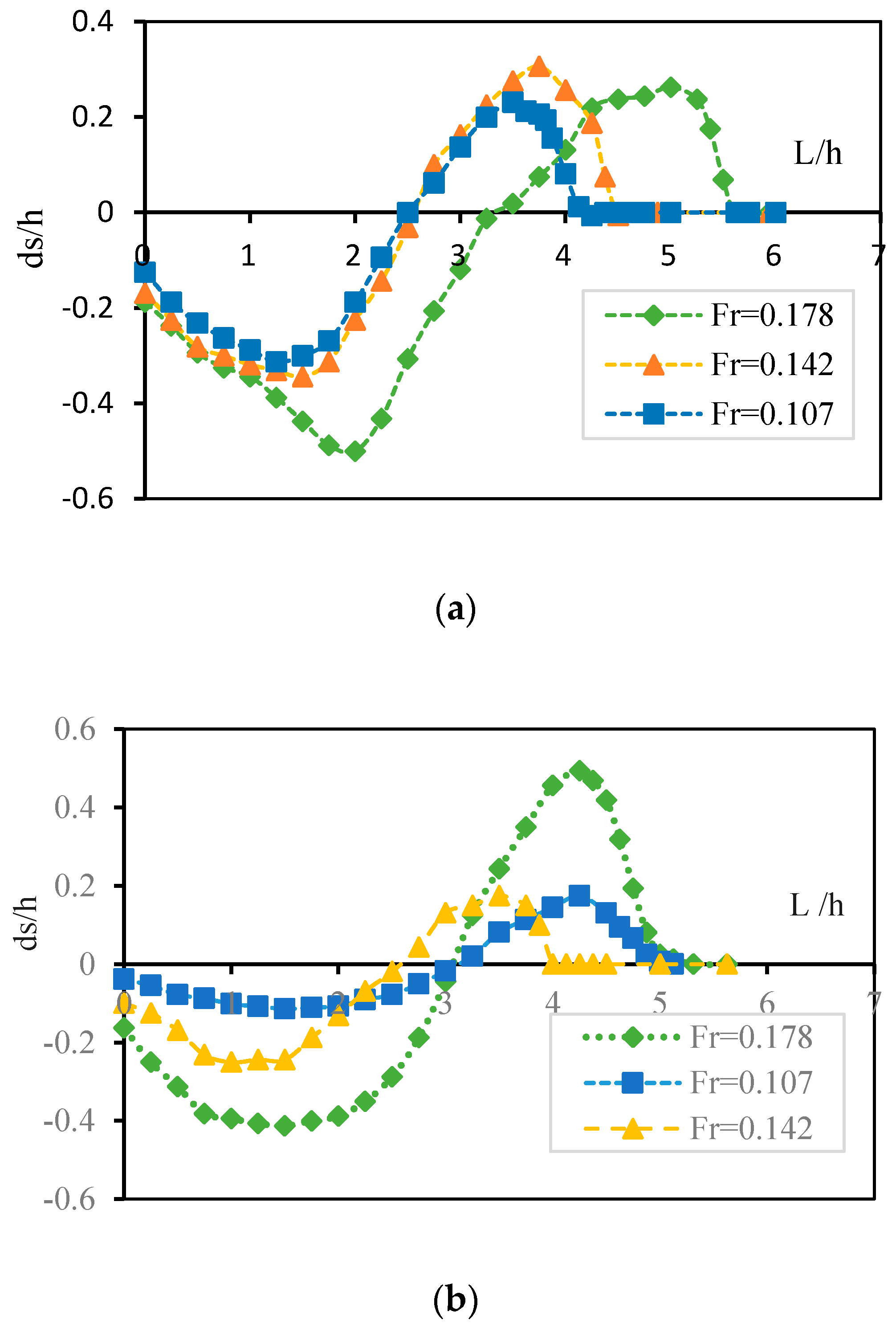
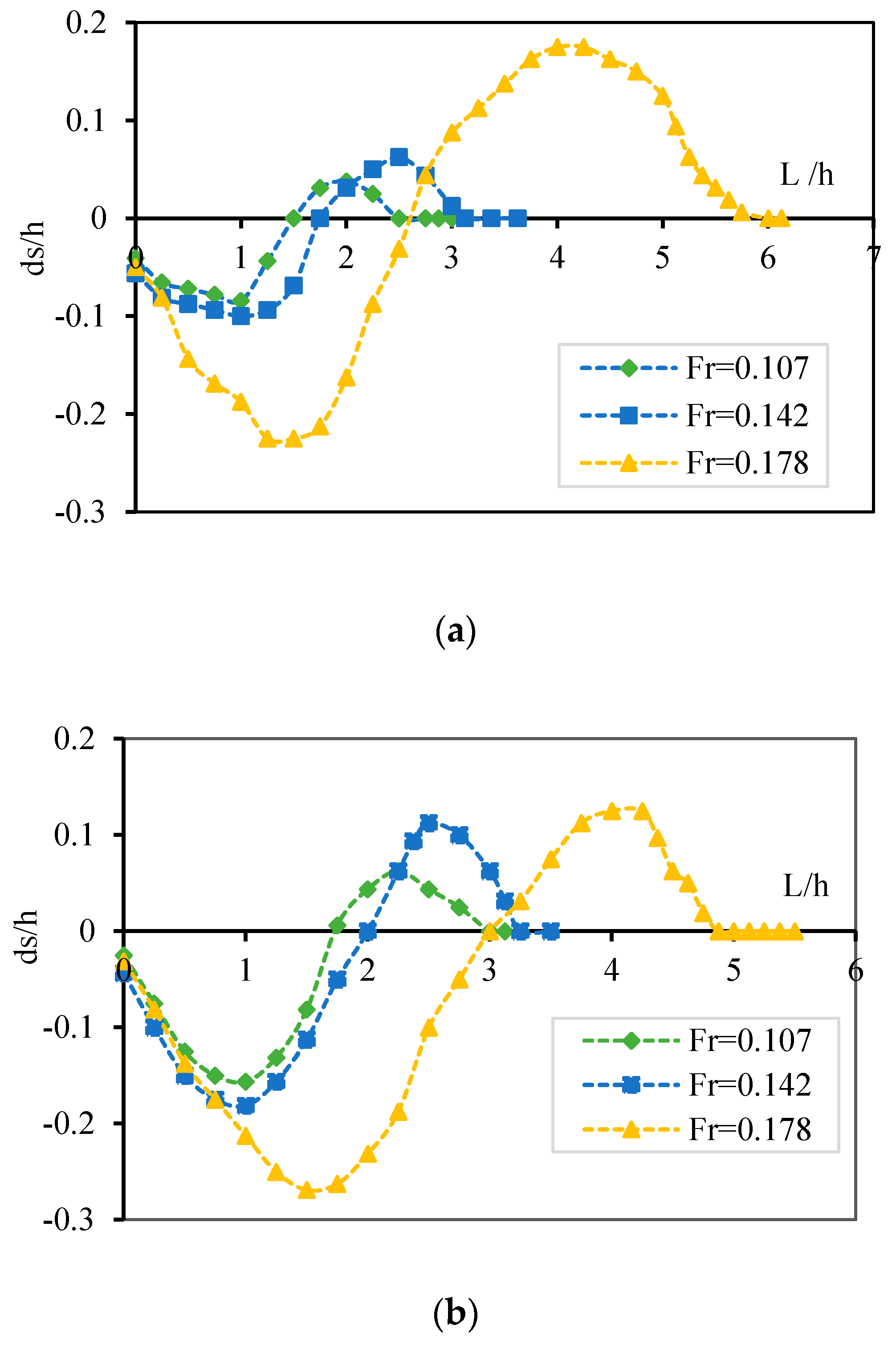


| Reference | Flume Dimension (m) | Sediment Info. | Type of Structure | Discharge Rate (L/s) | Investigated Scour Properties |
|---|---|---|---|---|---|
| Bhuiyan et al. [16] | FL: 14.96 m FW:1.6 m FS: 0.00133 SC: 1.38 | d50 = 1.5 mm | W-weir | 97, 164 | - Turbulence characteristic - Sediment transport - Scour development |
| Bhuiyan et al. [17] | FL: 14.96 m FW:1.6 m FS: 0.00133 SC: 1.38 | d15 = 0.95 mm d50 = 1.5 mm d90 = 3.2 mm | 1. W-weir 2. Vane | 97, 164 | - Flow pattern - Bed adjustment - Sediment transport - Scour after installed structures |
| Scurlock et al. [19] | FL: 15.24 m FW: 4.88 m FH: 1.22 m | d50 = 4.2–15.38 mm | 1. A-weir 2. U-weir 3. W-weir | 0.184 to 1.133 | - Maximum scour depth - Evaluation scour - Prediction methodology |
| Pagliara and Kurdistani [26] | FL: 7 m FW: 0.342 m | d50 = 3.52 mm Gs = 1.29 | 1. I-weir 2. U-weir | 2, 3, 4, 5 | - The shape of the structure - Scour hole width - Location of the maximum scour |
| Pagliara et al. [20] | FL: 20 m FW: 0.8 m FH: 0.75 m | d50 = 1.6 mm Gs = 2.6 σg = 1.26 | W-weir | 5, 7, 10, 25, 50 | - Scour development patterns - Location of maximum scour - Maximum ridge height and length - Maximum scour depth |
| Pagliara and Kurdistani [27] | FL: 20 m FW: 0.8 m FH: 0.75 m | d50 = 1.7 mm Gs = 2.6 σg = 1.16 | 1. Log vane 2. J-hook vane | – | - Scour parameters for different combinations and hydraulic conditions downstream of log-vanes and J-hook vanes |
| Bahrami Yarahmadi and Shafai Bejestan [22] | FW: 0.7 m R/B: 4 FH: 1.22 m | d50 = 1.5 mm σg = 1.22 | Vane | 25, 27, 30, 33 | - Flow pattern with and without vanes - Scouring and deposition - Maximum scour depth downstream of the vane. - Effective of variations in space between vanes |
| Kurdustani and Pagliara [25] | FL: 156.7 m FW: 0.5 m FH: 0.5 m | d50 =1.77 mm Gs = 2.6 σg = 1.26 | Cross vane | – | - Effect of channel bend radius on the scour - Scour morphology - Maximum scour hole - Structure orientation with respect to the flow direction |
| Present study | FL: 6.7 m FW: 0.35 m FH: 0.5 m SC: 1.12 | d50 = 1.5 mm σg = 1.21 | W-weir | 7.5, 10, 12.5 | - Maximum scour depth downstream of W-weir - The volume of the scour hole (length and width) - Height of W-weir - Optimize of the inner angle of the weir |
| Test Name | Q (m3/s) | Fr | τb | u* | Ro | Ho/h | θ | V (cm3) | Scour Type |
|---|---|---|---|---|---|---|---|---|---|
| Run 1 | 0.0075 | 0.107 | 0.211 | 0.0145 | 4.13 | 0.5 | 50 | 176 | B |
| Run 2 | 0.0075 | 0.107 | 0.211 | 0.0145 | 4.13 | 0.5 | 64 | 123 | B |
| Run 3 | 0.0075 | 0.107 | 0.211 | 0.0145 | 4.13 | 0.5 | 86 | 174 | B |
| Run 4 | 0.0075 | 0.107 | 0.211 | 0.0145 | 4.13 | 0.5 | 124 | 163 | C |
| Run 5 | 0.0075 | 0.107 | 0.211 | 0.0145 | 4.13 | 1 | 50 | 1386 | B |
| Run 6 | 0.0075 | 0.107 | 0.211 | 0.0145 | 4.13 | 1 | 64 | 603 | B |
| Run 7 | 0.0075 | 0.107 | 0.211 | 0.0145 | 4.13 | 1 | 86 | 677 | B |
| Run 8 | 0.0075 | 0.107 | 0.211 | 0.0145 | 4.13 | 1 | 124 | 750 | C |
| Run 9 | 0.0075 | 0.107 | 0.211 | 0.0145 | 4.13 | 1.5 | 50 | 3575 | B |
| Run 10 | 0.0075 | 0.107 | 0.211 | 0.0145 | 4.13 | 1.5 | 64 | 3027 | B |
| Run 11 | 0.0075 | 0.107 | 0.211 | 0.0145 | 4.13 | 1.5 | 86 | 3123 | C |
| Run 12 | 0.0075 | 0.107 | 0.211 | 0.0145 | 4.13 | 1.5 | 124 | 3774 | C |
| Run 13 | 0.010 | 0.142 | 0.364 | 0.0191 | 3.27 | 0.5 | 50 | 512 | B |
| Run 14 | 0.010 | 0.142 | 0.364 | 0.0191 | 3.27 | 0.5 | 64 | 426 | B |
| Run 15 | 0.010 | 0.142 | 0.364 | 0.0191 | 3.27 | 0.5 | 86 | 745 | B |
| Run 16 | 0.010 | 0.142 | 0.364 | 0.0191 | 3.27 | 0.5 | 124 | 756 | C |
| Run 17 | 0.010 | 0.142 | 0.364 | 0.0191 | 3.27 | 1 | 50 | 2525 | B |
| Run 18 | 0.010 | 0.142 | 0.364 | 0.0191 | 3.27 | 1 | 64 | 1148 | B |
| Run 19 | 0.010 | 0.142 | 0.364 | 0.0191 | 3.27 | 1 | 86 | 1920 | B |
| Run 20 | 0.010 | 0.142 | 0.364 | 0.0191 | 3.27 | 1 | 124 | 1827 | C |
| Run 21 | 0.010 | 0.142 | 0.364 | 0.0191 | 3.27 | 1.5 | 50 | 6343 | B |
| Run 22 | 0.010 | 0.142 | 0.364 | 0.0191 | 3.27 | 1.5 | 64 | 5599 | B |
| Run 23 | 0.010 | 0.142 | 0.364 | 0.0191 | 3.27 | 1.5 | 86 | 6525 | C |
| Run 24 | 0.010 | 0.142 | 0.364 | 0.0191 | 3.27 | 1.5 | 124 | 8911 | C |
| Run 25 | 0.0125 | 0.178 | 0.571 | 0.02391 | 2.51 | 0.5 | 50 | 943 | B |
| Run 26 | 0.0125 | 0.178 | 0.571 | 0.02391 | 2.51 | 0.5 | 64 | 859 | B |
| Run 27 | 0.0125 | 0.178 | 0.571 | 0.02391 | 2.51 | 0.5 | 86 | 1128 | B |
| Run 28 | 0.0125 | 0.178 | 0.571 | 0.02391 | 2.51 | 0.5 | 124 | 1900 | C |
| Run 29 | 0.0125 | 0.178 | 0.571 | 0.02391 | 2.51 | 1 | 50 | 5365 | B |
| Run 30 | 0.0125 | 0.178 | 0.571 | 0.02391 | 2.51 | 1 | 64 | 3231 | B |
| Run 31 | 0.0125 | 0.178 | 0.571 | 0.02391 | 2.51 | 1 | 86 | 4160 | B |
| Run 32 | 0.0125 | 0.178 | 0.571 | 0.02391 | 2.51 | 1 | 124 | 4687 | C |
| Run 33 | 0.0125 | 0.178 | 0.571 | 0.02391 | 2.51 | 1.5 | 50 | 8308 | B |
| Run 34 | 0.0125 | 0.178 | 0.571 | 0.02391 | 2.51 | 1.5 | 64 | 7404 | B |
| Run 35 | 0.0125 | 0.178 | 0.571 | 0.02391 | 2.51 | 1.5 | 86 | 10,692 | C |
| Run 36 | 0.0125 | 0.178 | 0.571 | 0.02391 | 2.51 | 1.5 | 124 | 13,216 | C |
| Plan View of Weir | θ | Lo/Li |
|---|---|---|
 | 50 | 1 |
 | 64 | 3/4 |
 | 86 | 1/2 |
 | 124 | 1/4 |
© 2017 by the authors. Licensee MDPI, Basel, Switzerland. This article is an open access article distributed under the terms and conditions of the Creative Commons Attribution (CC BY) license (http://creativecommons.org/licenses/by/4.0/).
Share and Cite
Abdollahpour, M.; Hosseinzadeh Dalir, A.; Farsadizadeh, D.; Gualtieri, C. Experimental Study on Erosion and Sedimentation Patterns Downstream of a W-weir in a Sinusoidal Mild Bend. Water 2017, 9, 638. https://doi.org/10.3390/w9090638
Abdollahpour M, Hosseinzadeh Dalir A, Farsadizadeh D, Gualtieri C. Experimental Study on Erosion and Sedimentation Patterns Downstream of a W-weir in a Sinusoidal Mild Bend. Water. 2017; 9(9):638. https://doi.org/10.3390/w9090638
Chicago/Turabian StyleAbdollahpour, Milad, Ali Hosseinzadeh Dalir, Davod Farsadizadeh, and Carlo Gualtieri. 2017. "Experimental Study on Erosion and Sedimentation Patterns Downstream of a W-weir in a Sinusoidal Mild Bend" Water 9, no. 9: 638. https://doi.org/10.3390/w9090638






